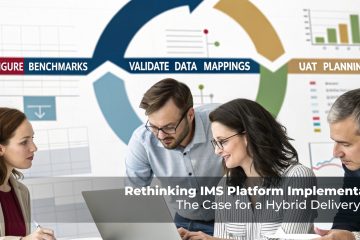Blockchain technology shows considerable potential in reshaping the finance industry, offering new pathways for innovation and efficiency. As financial systems evolve towards more digitized and decentralized frameworks, there is a growing interest in solutions that are secure, transparent, and efficient. Many FinTech companies are exploring the capabilities of blockchain to potentially streamline operations and improve transparency within the securities trading ecosystem.
This article explores five pivotal use cases of blockchain in post-trade settlements, highlighting how it helps achieve post-trade optimization and leads to better preparedness for T+1 and T+0.
Where Does Blockchain Fit in?
Blockchain, a decentralized digital ledger, records transactions across computer networks. Each block in the chain holds multiple transactions, and once registered, the data in any given block cannot be altered retroactively without altering all subsequent blocks. This ensures the immutability and security of the recorded data. Blockchain also employs smart contracts, which are self-executing contracts with the terms directly written into code. These contracts automatically perform actions under specified conditions, further boosting transaction efficiency and reliability.
Blockchain has gained significant traction in the financial sector with its ability to accelerate processes and enhance transparency.

Trade Confirmation and Settlement
In today’s financial markets, post-trade processing and settlement are typically characterized by multi-day delays due to manual reconciliation and the need for third-party verification. This delay not only exposes parties to risks such as market fluctuations that can affect the viability of a trade but also introduces the potential for errors in transaction records.
Based on a decentralized ledger, blockchain helps enabling real-time, immutable recording of transactions, paving the way for the instantaneous confirmation and settlement of trades. The integration of smart contracts further automates and secures these processes, thereby significantly reducing associated risks and enhancing operational efficiency.
In international settlements, blockchain cuts the need for intermediaries, reducing costs and delays in cross-border transactions. Using cryptocurrencies or digital tokens, blockchain has the potential to drive nearly instantaneous, cost-effective settlements globally, enhancing global trade dynamics. An excellent example of this in action is the Hong Kong Exchanges and Clearing Limited’s (HKEX) launch of the Synapse platform, which leverages blockchain to optimize post-trade processes in their equities market. Synapse integrates with their Stock Connect system, improving access to Chinese markets and streamlining the settlement process through advanced smart contracts.
The chart below displays the daily volume of U.S. equities trades across various exchanges, showing a total consolidated volume of nearly 10.5 billion for the day. Given the immense volume and complexity of settlements highlighted, blockchain technology could offer a more efficient and secure method for handling these transactions by enabling faster settlements and reducing the need for manual reconciliation.
Source: Cobe Global Markets
Clearing
The traditional clearing process in financial systems involves a central clearinghouse, which acts as an intermediary to mitigate risks by ensuring transactions are completed even if one party defaults. This setup, while necessary, introduces significant costs and creates a single point of failure that could lead to systemic disruptions.
Blockchain technology can help replace this with a decentralized framework, eliminating the need for traditional central clearinghouses. This shift towards a distributed ledger system allows all market participants to directly verify and reconcile transactions, enhancing transparency and reducing the risk of concentrated defaults. The immutable nature of blockchain ensures that once transactions are recorded, they cannot be altered, providing a transparent and permanent audit trail. This visibility significantly reduces fraud and operational errors, as any irregularities would be immediately apparent and challenging to manipulate without consensus across all nodes.
DTCC has been exploring the use of blockchain technology to improve their post-trade settlement processes through Project Ion, an initiative that utilizes distributed ledger technology (DLT) to create a more efficient and secure platform for the settlement of securities.
Furthermore, smart contracts on blockchain automate transaction execution and enforce contract terms, drastically reducing delays caused by manual processing. This automation accelerates settlements, lowers the risk of defaults by ensuring the timely fulfillment of obligations, and decreases transaction costs by minimizing intermediary involvement. As a result, market liquidity improves, facilitating faster fund reallocation and lessening financial strain on participants.
Collateral Management
Collateral management is the process of managing assets that borrowers pledge to secure credit or derivatives transactions, typically faces significant challenges in traditional financial systems, including time-consuming manual updates and high operational risks during market fluctuations.
Blockchain can help streamline this process by automating data capture, reporting, and management. Each transaction entry on the blockchain is time-stamped and immutable, significantly reducing human error and resource expenditure. This not only speeds up compliance activities but also enhances collateral management by providing a transparent ledger that gives all parties real-time access to collateral values. Such transparency and efficiency promote trust and stability in financial interactions, minimizing operational risks and administrative burdens.
A prime example of blockchain’s impact on collateral management is the collaboration between HQLAx and R3’s Corda platform. This partnership has developed a blockchain solution that facilitates the efficient transfer of high-quality liquid assets, enhancing the securities lending market by making collateral swaps more fluid and manageable.
Asset Management
Asset servicing involves crucial financial activities such as dividend distributions, corporate action management (like stock splits or mergers), and tax withholdings, traditionally prone to errors and delays due to manual processes.
Blockchain significantly improves asset servicing by utilizing smart contracts, which automate routine financial tasks. Once established, these contracts automatically execute transactions like dividend payments or tax withholdings when specific conditions are met, eliminating the need for manual intervention.
This automation reduces the chance of errors and delays, making asset management more efficient. Moreover, blockchain’s inherent transparency ensures that all actions are recorded securely and visibly, simplifying compliance and boosting investor confidence.
Regulatory Reporting And Compliance
Regulatory reporting and compliance in the financial sector often suffer from outdated methods, highlighted by incidents such as JP Morgan fined $350 Million for regulatory reporting failures. Blockchain has the capability to build robustness through its secure, immutable ledger system, enabling real-time access for regulatory oversight. This direct access facilitates quicker and more accurate audits, effectively minimizing the risk of errors and discrepancies that can slow down the compliance process.
With blockchain in the mix, all stakeholders can share a unified, transparent view of transaction records, enhancing both transparency and accountability. This innovation speeds up compliance processes and strengthens the integrity and stability of financial markets.
What Does The Future Hold?
Blockchain technology holds promise for the FinTech industry, offering more than just advancements in cryptocurrency. By leveraging its decentralized ledger capabilities, enterprises can enhance financial transaction efficiency, improve operational processes, and increase transparency in dealings with customers.
While blockchain can streamline transactions and reduce risks associated with counterparty interactions, it also encounters significant regulatory and compliance challenges. Effective use of blockchain in digital brokerage practices will require ongoing adaptation and diligent compliance efforts.
We specialize in developing and implementing brokerage technology solutions that enhance the efficiency and security of trading operations. If you’re interested in exploring how blockchain can benefit your organization, we’re well-equipped to assist. Feel free to get in touch.


